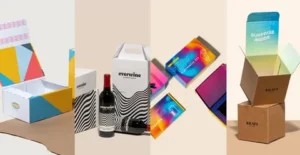What does it mean to emboss paper? What does about deboss? If you have these questions. You have come to the right place. Emboss and deboss paper are like two sides of the same coin when it comes to paper finishing. They both add an extra dimension and texture to your designs.
So, whether you want to make your design stand out or blend into the surface, these techniques have got you covered! Both processes have many applications including:
I hope this list gives you a better idea of the diverse applications of embossing and debossing. Now we will explain both these terms.
Table of Contents
ToggleEmboss Vs Deboss in 2024: What do you mean by these terms:
Embossing is a technique that creates raised designs on materials. Adding texture and depth. It involves applying pressure with a die or mold to imprint a design onto the surface. It’s like creating a 3D effect on the material.
Debossing:
It is the opposite of embossing. It creates depressed or indented designs on materials. It’s like creating sunken impressions instead of raised ones. This technique adds a unique and tactile element to the material’s surface.
Benefits of embossing and debossing:
Embossing and debossing offer several benefits:
It offers several benefits:
- Enhanced Visual Appeal: Emboss and deboss add a tactile and visually intriguing element to printed materials, packaging, and other surfaces.
- Brand Differentiation: These techniques help in making your designs stand out and create a unique identity for your brand.
- Luxury and Elegance: The raised or depressed textures created by embossing and debossing can give a sense of luxury, and high-quality craftsmanship.
- Brand Recognition: The distinct textures created by this term can help reinforce brand recognition and make your designs more memorable.
What is Embossing and debossing process in 2024?
These are processes used to create raised or depressed designs on materials. In embossing, a die is used to press into the material from the back creating a raised design on the front. Debossing, on the other hand. involves pressing the material from the front. creating a depressed or sunken design. Both techniques are commonly used in various industries for applications such as printing, packaging, stationery, and even leatherwork.
Uses of Embossing vs Debossing:
Embossing and debossing both have their unique uses and effects. Embossing is often used to add a raised and textured design to materials like paper, stationery, or packaging. It can be used for logos, patterns, or decorative elements. On the other hand, debossing creates a depressed or sunken design. which can create a more subtle and sophisticated look. It is often used for branding, letterheads, or business cards, giving them a sleek and tactile quality.
Pros And Cons of Emboss vs Deboss:
let’s dive deeper into the pros and cons of embossing versus debossing!
Embossing:
-Pros:
- Eye-catching texture: Embossing creates a raised design that adds visual interest to materials like paper or packaging.
- Versatility: It can be applied to various materials such as paper, cardstock, leather, or even foil.
– Cons:
- Higher Cost: The additional equipment involved in embossing can make it more expensive compared to other printing options.
- Limited Color Options: It can primarily focus on the textural effect and does not involve the application of vibrant colors.
Debossing:
–pros:
- Subtle elegance: It creates a sunken Adding a refined touch to materials.
- Durability: The debossed design is more resistant to wear and tear, as it is recessed into the material.
– Cons:
- Less visual prominence: Debossing may not be as visually striking as embossing since the design is pressed into the material rather than raised.
- Challenges with fine details: Achieving intricate or delicate details through debossing can be more difficult.
Overall, both embossing and debossing offer unique advantages and considerations.
Cost Difference:
When it comes to the cost difference between embossing and debossing. it’s important to consider a few factors. The higher cost of embossing can partially be attributed to the additional equipment and processes involved. On the other hand, debossing generally involves less intricate processes and equipment. making it a more cost-effective option in comparison. It’s important to keep in mind that the exact cost difference can vary depending on various factors such as the complexity of the design.
The size and quantity of the materials being embossed or debossed
Which one is Right for Packaging in 2024:
When it comes to packaging, both embossing and debossing can add a touch of elegance and sophistication. The choice between the two depends on the specific branding or design objectives you have in mind. Embossing creates a raised design that can make your packaging stand out and experience for the customers. On the other hand, debossing creates a depressed design, giving a subtle and classy look. Consider the overall aesthetic you want to achieve and how it aligns with your brand image.
Final thoughts:
In short, both techniques are very useful for all types of packaging (Flexible Packaging, Sustainable CPG packaging, Cardboard packaging, Metal packaging) Both techniques have a wide range of uses. The cost of both techniques is reasonable. Both techniques have several benefits.
FAQs
Why is Embossing and Debossing used in packaging?
Embossing and debossing are popular packaging techniques. They enhance consumer interaction through tactile and visual stimulation, boosting a brand’s distinctiveness and perceived quality. These methods create standout features, elevate product appeal, and foster a memorable unboxing experience, all without a significant financial investment.
What are the styles of Embossed and Debossed paper?
-
Blind Embossing: Doesn’t use ink or foil stamping, creating a clean and subtle design.
-
Registered Emboss: Uses ink, foil stamping, or another effect for dimension and a polished appearance.
-
Combination Embossing: Combines foil stamping and blind embossing for impactful 3D designs, often used to highlight key details like logos or slogans.
What are the different die types used in Embossing paper?
-
Single-Level: Changes material at one level, the most common and economical.
-
Multi-Level Emboss: Features several distinct levels for added depth.
-
Bevel-Edge: Similar to single-level, but with a 30 to 60-degree angle on the design’s edge to prevent cutting.
-
Chisel: Primarily used for debossing, featuring a distinct ‘roof’ or v-shape.
-
Textured: A single-level die with etched texture, suitable for artwork not requiring intricate details.
-
Rounded: Produces rounded corners, often used for logos and typography.
-
Sculptured: The most expensive, requiring a custom-made sculpt for stamped or embossed patterns.
Both techniques involve the manipulation of materials using pressure and molds or dies to create designs. They are similar in their method of application but opposite in the visual and tactile results they produce; embossing results in a raised design, while debossing results in a recessed design.
Embossing modifies materials by forming raised patterns or designs that stand out from the surface, giving a three-dimensional effect. Debossing, conversely, presses designs into the material, creating a recessed or indented effect.
Embossing and debossing are utilized in creating enhanced visual and tactile elements in products such as brochures, postcards, business cards, letterheads, certificates, folders, and various types of packaging.







